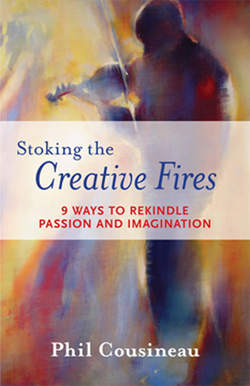Читать книгу Stoking the Creative Fires - Phil Cousineau - Страница 24
На сайте Литреса книга снята с продажи.
FROM REVERIE TO CREATIVITY
ОглавлениеWhen Navajo sculptor Nora Naranjo-Morse wants to make her beautiful clay vessels, she drives out to a riverbed her mother showed her when she was a child. “When I come here I'm excited, I'm like a child,” she says in Michael Apted's brilliant documentary film, Inspirations.
Nothing can hurt me. No one is going to say anything mean to me here. Everything is so peaceful, and beautiful, and perfect, so I just open up. That's exactly what we're supposed to do; that's exactly what I'm looking for when I'm going to create, that I'm opening up. I'm opening up to this force that I'm not afraid of and that I can just let myself fall into and be inspired. I think about the people I love, and think about the things around me so that when I go back to my home and my studio I carry this with me and I'm able to create and open up again and let it all flow into those vessels I'm making.
For Nora and many other indigenous people I've known, the “where” in question doesn't refer to a physical place as much as metaphysical one. Their focus and reverence is on the heightening of spiritual sensibilities, the celebration of the Great Mystery.
“It's all about reverie,” says Gregg Chadwick, a visionary oil painter from Southern California. He told me in a recent conversation that, “I need some kind of flight if I'm going to create on the canvas what I see in my head. To get that effect, I need to capture a kind of timelessness and leave the mystery of the world between memory and dream intact.”
Over the last decade, Chadwick's work has been inspired by his years crisscrossing Southeast Asia as the son of a career military officer. There, his eyes were opened to the intersecting paths of art, music, literature, and religion. His paintings of Buddhist monks and temples and the accelerating pace of life explore the ephemeral aspects of reality. His most profound challenge is offering his viewers an opportunity to be as transported as he is when he paints. “I have to get into a special mood to create the art and not just product. So I'm very careful about the music I play, what's hanging on the walls of my studio, the books stacked in the corner, what I've been eating that morning, even conversations with my son.” His work springs from a fierce soul-struggle, living proof that, if you want to be original, you have to learn to trust your reveries, your voice, your vision, and resist the temptation of style and fashion. Otherwise you'll never, as Bob Marley sang so thrillingly, “Satisfy your soul.”
“What if,” Coleridge wondered, “in your dream you went to heaven and there plucked a strange and beautiful flower? And what if, when you woke, you had the flower in your hand? Ah! What then?” In the spring of 2002, P. J. Curtis, a Dublin DJ and music producer, told me a strange story in an old country pub in County Clare. His aunt had so many dreams in which she heard “fairy music” that she took to keeping a pencil tied to her bedpost so she could write down the music in the middle of the night. By the time she died, the wallpaper in her bedroom was festooned with musical notation from her dreams, some of which was eventually recorded by famed Irish groups like the Chieftains and the Dubliners.
Amazing grace, we might say. But the rational mind cries out: What's happening here? In Lifetide, biologist Lyall Watson attempts an explanation: “Hieronymus Bosch and William Blake did it visually, Samuel Taylor Coleridge and James Joyce managed it with words. They succeeded in diverting the stream of consciousness in ways that allowed dream imagery to survive in the harsh light of day . . . We do it every time we daydream.”
The trick is to make the dream come alive. To do that, we have to “make something out of it.” We don't truly know ourselves until we put our experiences into words or images with love and abandon.
